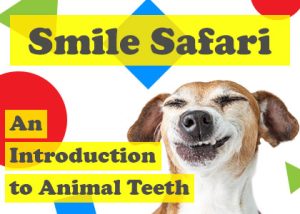Smile Safari: An Introduction to Animal Teeth
Posted on January 27th, 2024
 If you and your child are the proud companions of a pet, there’s a good chance you’ve both thought or said something like: “Fluffy’s really living the life. Instead of having to go to school or do chores, they can relax and sleep all day, getting up only to eat or maybe chase a laser if they’re feeling feisty.” However, Fluffy also doesn’t have to floss and brush their teeth, so how do Fluffy’s teeth manage not to suffer from disease and decay?
If you and your child are the proud companions of a pet, there’s a good chance you’ve both thought or said something like: “Fluffy’s really living the life. Instead of having to go to school or do chores, they can relax and sleep all day, getting up only to eat or maybe chase a laser if they’re feeling feisty.” However, Fluffy also doesn’t have to floss and brush their teeth, so how do Fluffy’s teeth manage not to suffer from disease and decay?
Contemplating this may lead you and your little one to wonder about all kinds of different animal mouths and how they remain clean and strong. Dr. Chad Johnson of Veranda Dentistry happens to love talking about teeth of all types, so keep reading to go on a toothy smile safari!
Myth Busting
Before we start listing fun facts about animal teeth of different species, we’ll answer the question we asked first about Fluffy’s teeth seeming impervious to decay. The myth that dogs have cleaner mouths than humans has existed for some time even though they lick themselves daily and have an affinity for things as yucky (and potentially toxic) as soiled kitty litter. Our mention of these particular habits and the word myth probably clues you into the truth, but we’ll explain in more detail.
Human mouths are home to anywhere from 650 to 1,000 different types of bacteria at any given moment, while the number of bacteria in the mouth of a dog may hover around 600. On its own, this fact might make you believe that pervasive myth, but diets and the types of bacteria are important to keep in mind. Dogs shouldn’t be ingesting sugar the way many humans do, making cavities less likely to form in their teeth, but both humans and dogs are likely to develop gum disease without a solid oral hygiene routine.
Doggy Dental Care
You read right—canine friends need help cleaning their mouths to prevent periodontal disease (the advanced form of gum disease), which can lead to tooth loss. You can softly brush your buddy’s teeth and gums with a toothpaste meant for dogs, as toothpastes meant for humans can contain ingredients like xylitol, which is very harmful to your beloved pooch. Giving them treats with the seal of approval from the Veterinary Oral Health Council is helpful, too! And be sure not to smooch your pooch on the mouth, as harmful bacteria can be transferred easily! Mothers, lovers, and dogs are the most common sources of gum disease infections.
If you’re curious about your feline friend, research suggests their oral bacteria is very similar to a dog’s. One big distinction between their mouths is the tongue. Why do cats have rough barbs (known as papillae) on their tongues? Simple—they help remove dirt, debris, and loose hair from their coat, but their primary function is to scrape flesh from their prey’s bones—they’re animals after all, even if we’ve domesticated them. A look at their diets (or what their diets would be if they weren’t our sweet housemates) brings us back to the topic of animal teeth!
Sharp or Dull, Long or Short, Numerous or Few?
The different types of teeth you’ll find in an animal’s mouth provide clues on what they eat! Can you imagine a cow’s mouth with teeth like a dog’s? That wouldn’t be helpful for them to chew grass, leaves, and other plant matter, which is why you’ll find rows of flat, wide teeth in the mouths of herbivores (plant-eaters) like horses, camels, cows, sheep, and goats. The jaws of these animals are also capable of moving sideways, which helps them grind the food between their molars for healthy digestion.
When it comes to the mouths of carnivores (meat-eaters), you’ll find a mouthful of long, pointed (sharp) teeth that help lions, tigers, foxes, wolves, and the Tyrannosaurus Rex (testing to be sure you’re still with us), grip and cut the meat of their prey. Flat teeth meant for chewing aren’t necessary for these eaters, because they’re able to swallow and digest larger chunks of food.
If an animal eats both meat and plants, they can be referred to as an omnivore and will have a combination of sharp and flat teeth for their varied diet.
Teeth as Tools
While Veranda Dentistry strongly advises you and your child stick with using your teeth for speaking, eating, and smiling, there are animals that can use their teeth for other activities. For example, elephant tusks are actually teeth, and they use them both defensively and like hands as they lift and carry objects, and even dig with them. If they lose a set of tusks, they can grow replacement tusks up to six times in their lives. If you think that’s incredible, wait ‘til you read about shark teeth!
Sharks lose teeth each week! They’re not attached to gums like human teeth and may break or come out clean when they’ve chomped into their prey. Luckily for sharks, they can grow a replacement tooth within a day of losing one. This leads to the phenomenal presence of over 20,000 teeth in one shark’s lifetime!
There are so many astounding facts to learn about the animals we share a planet with, and we love to share what we know with our young (and not so young) visitors. Unlike elephants and sharks, you and your little one are given just one set of permanent teeth. We’re here to help ensure they’re healthy for a lifetime of happy smiles, so contact your Des Moines dentist at Veranda Dentistry today to schedule a checkup!
The content of this blog is not intended to be a substitute for professional medical advice, diagnosis, or treatment. Always seek the advice of qualified health providers with questions you may have regarding medical conditions.


